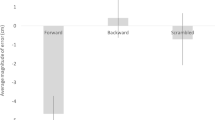Abstract
For many years, the Müller-Lyer illusion was studied as a purely “visual” illusion, but like many other optical illusions, the evidence now shows that it also occurs when stimuli are presented tactually. In the present study, we investigated whether the visual perception of the illusion would have any crossmodal consequences for haptic perception. The wings-in and wings-out parts of the Müller-Lyer illusion were placed end-to-end, sharing a central fin. This Brentano version of the illusion was presented visually on a screen in front of the participants, who had to compare the “felt” length of two sticks placed on the back of the screen, one behind either part of the illusion. Our results show that the presentation of the visual illusion modified the felt lengths of the sticks presented directly behind the illusion. In particular, the stick presented on the side of space perceived visually as being shorter (behind the wings-in part of the display) was perceived as longer, and vice versa for the stick mounted behind the space perceived visually as longer (behind the wings-out part of the display). These results highlight the crossmodal consequences of the visual perception of the Müller-Lyer illusion for the haptic perception of line length.



Similar content being viewed by others
References
Aglioti S, DeSouza JF, Goodale MA (1995) Size-contrast illusions deceive the eye but not the hand. Curr Biol 5:679–685
Blumenfeld W (1937) The optical and haptic construction of space. Acta Psychol 2:125–175
Bowers D, Heilman KM (1980) Pseudoneglect: effects of hemispace on tactile line bisection task. Neuropsychologia 18:491–498
Bradshaw JL, Nettleton NC, Nathan G, Wilson L (1983) Head and body space to left and right, front and rear. II. Visuotactual and kinaesthetic studies and left-side underestimation. Neuropsychologia 21:475–486
Brenner E, Smeets JB (1996) Size illusion influences how we lift but not how we grasp an object. Exp Brain Res 111:473–476
Bruno N, Bernardis P (2003) When does action resist visual illusions? Effector position modulates illusory influences on motor responses. Exp Brain Res 151:225–237
Calvert GA, Spence C, Stein BE (eds)(2004) The handbook of multisensory processes. MIT Press, Cambridge, MA
Coren S (1970) Lateral inhibition and geometric illusions. Q J Exp Psychol 22:274–278
Coren S, Girgus JS (1978) Seeing is deceiving: the psychology of visual illusions. Lawrence Erlbaum, Hillsdale, NJ
Daprati E, Gentilucci M (1997) Grasping an illusion. Neuropsychologia 35:1577–1582
Driver J, Spence C (1998) Attention and the crossmodal construction of space. Trends Cognitive Sci 2:254–262
Erlebacher A, Sekuler R (1969) A conclusion on confusion in the illusion of Muller-Lyer. P Annu Conv Am Psychol Assoc 4:27–28
Fleming J, Behrmann M (1998) Visuospatial neglect in normal subjects: altered spatial representations induced by a perceptual illusion. Neuropsychologia 36:469-475
Fry CL (1975) Tactual illusions. Percept Motor Skill 40:955–960
Goodale MA, Milner AD (1992) Separate visual pathways for perception and action. Trends Neurosci 15:20–25
Gregory RL (1966) Eye and brain. McGraw-Hill, New York
Haffenden AM, Goodale MA (1998) The effect of pictorial illusion on prehension and perception. J Cognitive Neurosci 10:122–136
Heller MA, Brackett DD, Wilson K, Yoneyama K, Boyer A (2002) The haptic Müller-Lyer illusion in sighted and blind people. Perception 31:1263–1274
Jewel G, McCourt E (2000) Pseudoneglect: a review and meta-analysis of performance factors in line bisection tasks. Neuropsychologia 38:93–110
Judd CH (1902) Practice and its effect on the perception of illusions. Psychol Rev 9:27–39
Köhler W, Fishback J (1950) The destruction of the Müller-Lyer illusion in repeated trials. J Exp Psychol 40:267–81
McPherson A, Renfrew S (1953) Asymmetry of perception of size between the right and left hands in normal subjects. Q J Exp Psychol 5:66–74
Millar S, Al-Attar Z (2000) Vertical and bisection bias in active touch. Perception 29:481–500
Millar S, Al-Attar Z (2002) The Müller-Lyer illusion in touch and vision: Implications for multisensory processes. Percept Psychophys 64:353–365
Neisser U (1976) Cognition and reality. Freeman, San Francisco
Porac C (1994) Comparison of the wings-in, wings-out, and Brentano variants of the Mueller-Lyer illusion. Am J Psychol 107:69–83
Pratarelli ME, Steitz BJ (1995) Effects of gender on perception of spatial illusions. Percept Motor Skill 80:625–626
Predebon J (2001) Spatial range of illusory effects in Müller-Lyer figures. Psychol Res 65:226–34
Rudel RG, Teuber HL (1963) Decrement of visual and haptic Mueller-Lyer illusion on repeated trials: A study of crossmodal transfer. Q J Exp Psychol 15:125–131
Spence C, Driver J (eds)(2004) Crossmodal space and crossmodal attention. Oxford University Press, Oxford, UK
Tsai LS (1967) Müller-Lyer illusion by the blind. Percept Motor Skill 25:641–644
Vallar G, Daini R, Antonucci G (2000) Processing of illusion of length in spatial hemineglect. A study of line bisection. Neuropsychologia 38:1087–1097
Von Bekesy G (1967) Sensory inhibition. Princeton University Press, Princeton, NJ
Walker JT (1971) Visual capture in visual illusions. Percept Psychophys 10:71–74
Wertheimer M (1954) Constant errors in the measurement of kinesthetic figural aftereffects. Am J Psychol 67:543–546
Acknowledgements
A. G. was supported by a grant of Universita’ di Milano Bicocca. Correspondence regarding this article should be addressed to Alberto Gallace, Room B121, Department of Experimental Psychology, University of Oxford, Oxford, UK, OX1 6UD. E-mail: alberto.gallace@psy.ox.ac.uk.
Author information
Authors and Affiliations
Corresponding author
Rights and permissions
About this article
Cite this article
Gallace, A., Spence, C. Examining the crossmodal consequences of viewing the Müller-Lyer illusion. Exp Brain Res 162, 490–496 (2005). https://doi.org/10.1007/s00221-004-2130-8
Received:
Accepted:
Published:
Issue Date:
DOI: https://doi.org/10.1007/s00221-004-2130-8




